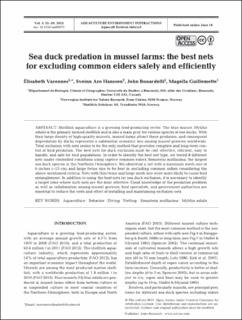Sea duck predation in mussel farms: the best nets for excluding common eiders safely and efficiently
Peer reviewed, Journal article
Published version

Åpne
Permanent lenke
https://hdl.handle.net/11250/3077134Utgivelsesdato
2013Metadata
Vis full innførselSamlinger
- Publikasjoner fra CRIStin - NINA [2364]
- Scientific publications [1392]
Sammendrag
Shellfish aquaculture is a growing food-producing sector. The blue mussel Mytilus edulis is the primary farmed shellfish and is also a main prey for various species of sea ducks. With their large density of high-quality mussels, mussel farms attract these predators, and consequent depredation by ducks represents a substantial economic loss among mussel growers worldwide. Total exclusion with nets seems to be the only method that provides complete and long-term control of bird predation. The best nets for duck exclusion must be cost effective, efficient, easy to handle, and safe for bird populations. In order to identify the best net type, we tested 8 different nets under controlled conditions using captive common eiders Somateria mollissima, the largest sea duck species in the Northern Hemisphere. We identified a net with a maximum mesh size of 6 inches (~15 cm) and large twine size to be best in excluding common eiders considering the above-mentioned criteria. Nets with thin twine and large mesh size were more likely to cause bird entanglement. In addition to using the best nets for sea duck exclusion, it is necessary to identify a target zone where such nets are the most effective. Good knowledge of the predation problem as well as collaboration among mussel growers, bird specialists, and government authorities are essential to reduce the costs and effort of installing and maintaining exclusion nets. Aquaculture, behavior, diving, netting, somateria mollissima, ytilus edulis Sea duck predation in mussel farms: the best nets for excluding common eiders safely and efficiently
